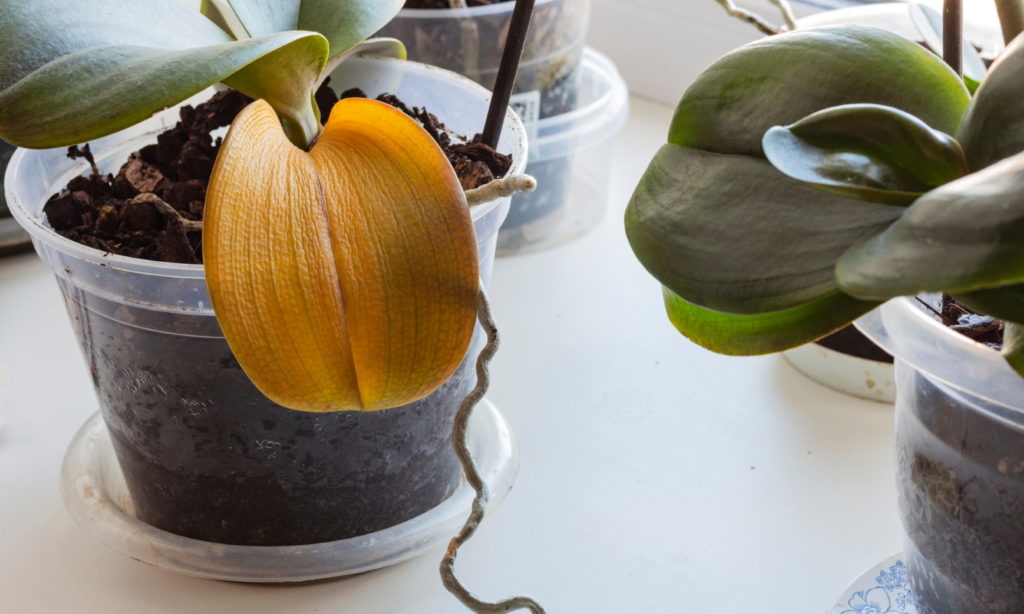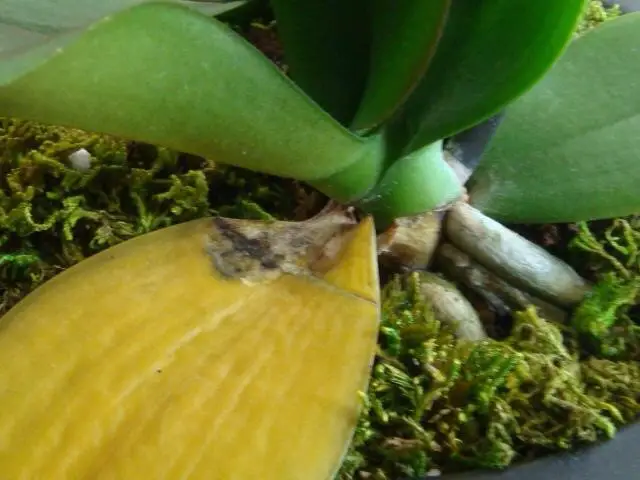Orchid is one of the most eye-catching flora that enhances the attractiveness of every garden. It is of different types, and every class has its worth. It would be best if you took care of these plants for, they are a beautiful contribution to your garden. Keeping an eye on the leaves of these plants will help identify the health of your plant.
Orchid leaves can turn yellow for a variety of reasons. In this article, we will explore some of the most common causes of yellow leaves on orchids and how to treat them
Reasons Behind Why Yellow Leaves on Orchids
Let us have a look at the reasons behind:

1. Check if your Orchid is getting Enough Light:
If a plant is directly exposed to the sunlight for a more extended period, then there are chances that the leaves can turn out to be yellow.
It would help if you analyzed the areas around the leaves as well. If these areas appear to be brown or patchy, then overexposure to the light is causing yellowing of the leaves.
So, you must place the orchid plants in indirect sunlight to prevent them from yellowing. The best direction for these plants to get the indirect lights is if windows face east or north.
What to do if you don’t have windows in these directions?
Do not worry; Orchid can grow the same in artificial light as well.
2. Imbalance in the Temperature Demands:
Orchid leaves turn out to be yellow in case the temperature is low. The optimum level of temperature for Orchid is between 65 and 80 Fahrenheit. This temperature will help your plant thrive.
Other than this, you are also supposed to place your plant away from the open windows because it impacts these plants’ health. Also, it is recommended to keep these plants away from the fans and the air conditioner.
A recommendation that can help your plant to grow healthy is the balance in the humidity levels. You are supposed to place your plant between 55 and 75 percent humidity, as they are not draft lovers.
3. Overwatering:
Overwatering is one of the leading causes that cause yellowing of the orchid leaves. This is root rot, and it does not let the plant grow healthily.
4. Solution for Root Rot:
If your orchid plant suffers from root rot, then you are recommended to place the plant in a new pot. It will help in the recovery and the growth of the plant. You can also trim the green roots from the plant to grow a fresh orchid.
5. Three Cubes are enough for your Orchid:
One interesting fact about these orchids is that three cubes are enough to promote the healthy growth of the plant. The rationale for using ice cubes is due to their slow-melting nature.
Also check: Why Are My Pothos Leaves Curling?
Diseases can Cause Yellow Leaves on Orchids
Your Orchid leaves also come out to be yellow in case of a bacterial, fungal attack. In case your orchid plant has a spotty appearance on it, then it is most probably suffering from a fungal attack.
In this case, your Orchid smells okay, and the yellow areas will arise from the underside of the leaves. Also, if spots are present on both sides, it can make the leaf turn brown or black.
In case of a bacterial attack, you will experience a foul smell in your plant. Bacterial attacks also make your plant leaves yellow, but it is less adverse than fungal attacks.

What to do in case of Disease Infection?
You are advised to take your orchid plant away from the other plants. After that, use a sterile razor to remove the infected areas of the plant.
Spray the orchid plant with a fungicide to prevent further infectious spread.
Seasonal Changes:
Seasonal changes are not easy for the plants to handle, and the environmental fluctuations can cause yellowing of the leaves. At the time of seasonal change, oscillations can be addressed in humidity, light, and temperature.
These changes are sometimes not accepted by the plants leading to the destruction of their health.
You are recommended to restore the optimum conditions of the plant using the artificial medium.
Nutrient Deficiency:
It is a fact that nutrients are highly essential to help plants thrive. Although Orchids are not that heavy feeders, they don’t feed them for months, leading to the yellowing of leaves.
At first, the Orchid will not flower that much leading to stunt growth as well. The yellow leaves on the orchid plant also experience falling off in these cases.
You recommended using orchid-friendly fertilizer for the protection and the plant’s recovery.
The rationale behind the yellowing of orchid leaves is that the plants struggle to absorb iron in excessive nitrogen and magnesium.
So, the iron absorption will cause yellowing of the leaves from the middle and outward. It is the case when you intend to use excessive fertilizer.
Maybe you also like: Complete Guide Rhaphidophora Tetrasperma: How to Care & Grow

Tips that can help you Prevent Orchid Leaves Turning Yellow
- You are advised to check and monitor the yellowing of the leaves from time to time to determine the root cause. The first thing to check is the roots of the plant.
- Also, you are recommended to take out the plant’s roots to match their color. If the color of these roots is gray, white, or black, you must adjust the watering conditions.
- Several factors take part in the plant’s healthy growth, including temperature, environment, and humidity issues. It would be best if you kept these conditions balanced.
- Root rot can also cause yellowing of the leaves, so in this case, you must remove the dead parts of the root.
- So, if you also experience likely issues with your Orchid, you must not panic and devise the solutions as per the plant’s requirements. Your plant needs your time and care, and it’s enough to make them grow healthy.
Check How Fast Does Aloe Vera Grow?
Final thoughts:
To conclude, if your orchid leaves turn out in yellow color during flowering, you must devise ways immediately to promote the healthy growth of the plant. Do not let your beautiful orchids turn yellow, and give them proper attention and time.
Although the plant has to experience yellowing of the leaves with age, it needs your care. Keep the growing conditions optimum and see your plant grow beautifully.
Frequently asked Questions about Yellow Leaves on Orchids
Why are the leaves on my Orchids turning Yellow?
One of the leading reasons that cause yellowing of the orchid leaves is overwatering. The reason that leads to overwatering is that the roots are cut off from the air and hence cannot transport nutrients and other minerals to the upper part of the part. Therefore, finally, the plant loses its elasticity and leads to less efficiency of the root system. It is how the Orchid’s leaves turned out in yellowing of leaves.
How to take care of Yellow Leaves on Orchids?
You must provide the plant with balanced environmental conditions with the optimum water, nutrients, light, and fertilizer. Hence, your orchid plant will stay happy, and you must not worry about it.
What Causes Yellow Leaves on Orchids?
The primary reasons that lead to the yellowing of the Orchid’s plant are overwatering, excess exposure to the light, and the high or the low temperature. Other than this, the plant’s diseases can also cause this issue.
Can I save my Orchid with Yellow Leaves?
The leaves of the Orchid plant shed out automatically, and hence you are supposed to wait for it. After that, you can also peel the area using a knife, as it will help prevent the yellowing of other leaves.
How can I fix my Orchid in case of Overwatering?
It is one of the most common causes of the yellowing of the plant. You can figure out a way in case if you identify the issue in real-time. Removing the root rot or the mushy part of the plant will help in the fast recovery of the plant. After that, place the plant in the fresh pot to help it grow.
